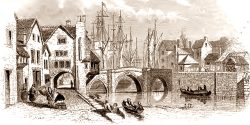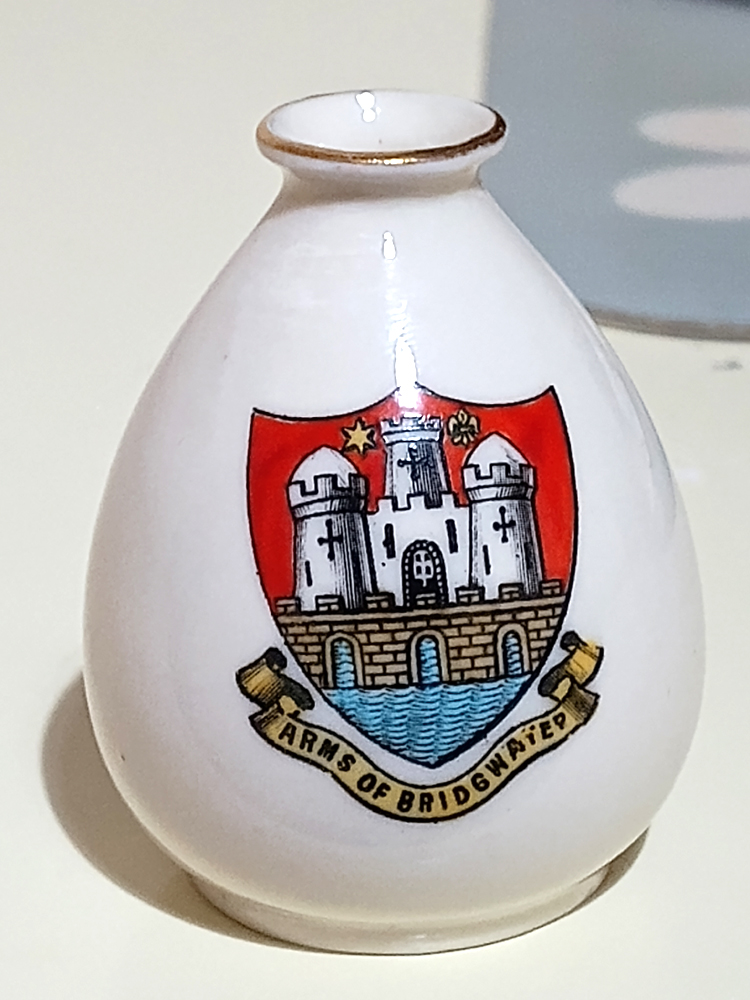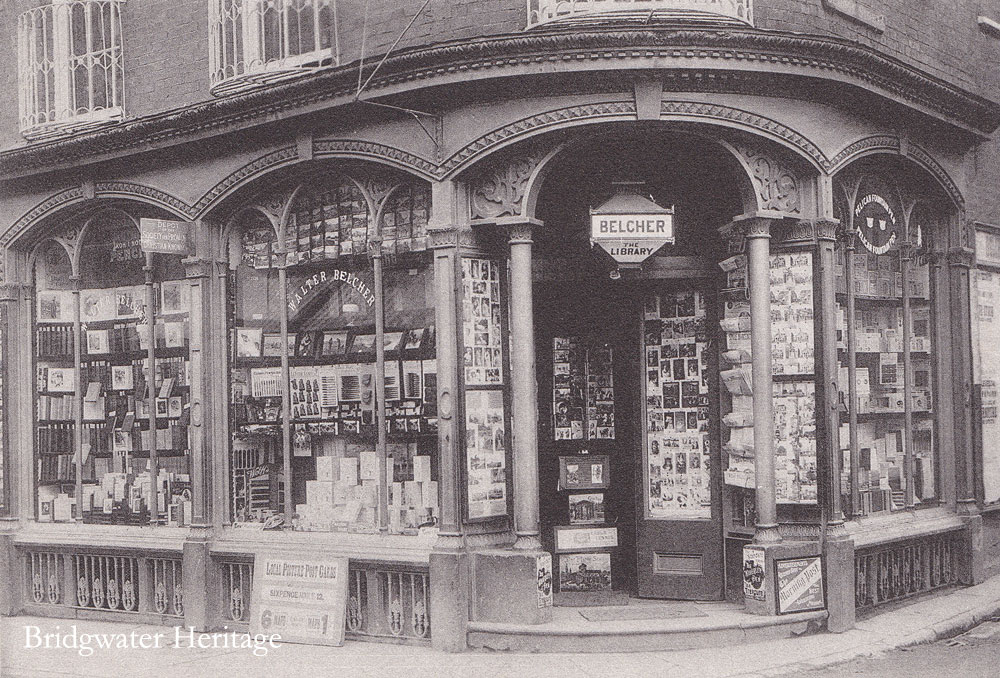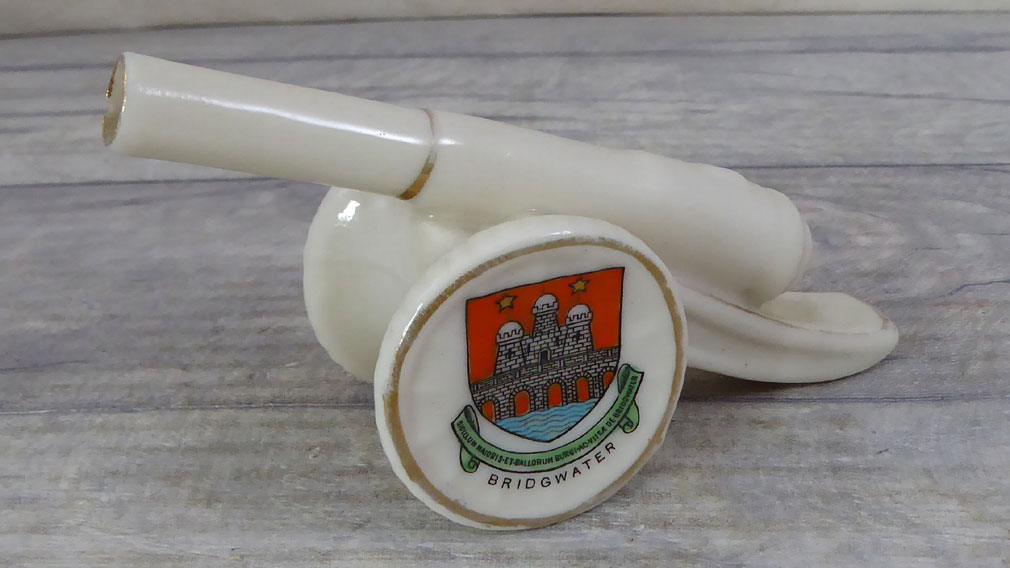Crested China also known as ‘Heraldic China’ was one of the more popular types of tourist trinket produced in the very late Victorian and Edwardian periods. It found its zenith in the years after the First World War. Most homes would have had one or two of these little keepsakes as fond memories of a happy holiday. These little, relatively inexpensive items would be sold in small shops, such as stationers and newsagents. The manufacturers were primarily based in Stoke on Trent, although a number of continental factories produced examples which were imported into Britain. They would have either sent sales agents or catalogues to the local vendors, who would have selected designs that would then be painted with the town’s arms.
Bridgwater was not especially special when it came to the creation of crested China: almost every town in the country had items produced, but the Bridgwater is an interesting case study in the tastes of the time. The surprising quantity of crested China produced with Bridgwater crests is a reminder that Bridgwater was once a popular tourist town, being a stopping off point for onward travel to the Quantocks or further into the West Country. The items listed here are by no means exhaustive: dozens of different designs were produced, the selection here are some of the more interesting examples.
Crested China relating to Bridgwater created fictitious arms based on the Borough Seal. Most seem to have taken the design from Bridgwater’s gilded silver maces of the mid-seventeenth century. Presumably a local shopkeeper chose a shape or shapes from a travelling salesman’s catalogue, the arms would have been agreed and an order placed. Most of these ornaments were made of a glazed ivory ceramic, most were of glazed parian but some were produced in bone china. The manufacturers seem to have introduced colour to the seal, which were later officially adopted when the town was granted a Coat of Arms on 19 September 1952.
Although crested china is still be collected, its value has diminished in recent years. This sort of nostalgic ornament is not something for most modern tastes. That said, there is something quite charming in them. Some of the designs are very well executed, others are hilariously bad and worth enjoying for their kitsch value.
Notes on the potteries and trademarks have been linked to the sources, otherwise they have been taken from Nicolas Pine, the Price Guide to Crested China, 2000 edn, Milestone Publications, Horndean.
Who was commissioning these and where were they sold?
This is a miniature three-handled friendship cup, about 39mm tall and 51mm wide. This was known as a tig, or tyg, and was popular in the late middle ages. The idea was to be able to pass around hot beverages without anyone burning their hands. This was a very popular form of crested china. This one is interesting in that it depicts three sets of arms: Bridgwater, ‘Somerset’ (actually Taunton) and the arms of Robert Blake, General at Sea.



The underside of this cup tells us it was made by W. & R. (Wiltshaw & Robinson) at the Carlton Works in Stoke on Trent, using a stamp that was in use between 1902 and 1930. The handwritten 98 B will probably be a pattern or shape number, while an additional stamp tells us that this was retailed by Walter Belcher, Stationer of Fore Street. (more on Carlton can be found below)

This second example, above, kindly provided by Jon White, is another simple example by Carlton with Belcher’s overstamp. Whether Belcher was responsible for examples without a stamp, or only those with his stamp, is yet to be established.
Walter Belcher was the son of William Belcher of Chippenham. He moved to Bridgwater from Bolton in 1890 (where he had worked for Mr J.W Gledsdale), where took over the printing and stationary business on the corner of Fore Street and George Street, where he was tenant (The Bookseller, October 10 1890, Trade and Literary Gossip; with thanks to Jon White for finding this source). The property included shop, library and workshops (West Somerset Free Press, 24 October & 7 November 1896). He married in 1901 Sarah Anne (Annie) Salway of Moorlinch (West Somerset Free Press 4 May 1901). Belcher was also a leading figure in the town’s Oddfellows’ mutual support organisation (Chard and Ilminster News 8 March 1902). He retired in 1930 and died in 1938.
C.G. Batten
Another example has another retailers name. This rather bizarre, and somewhat unimaginative model of a water pump, below, was made by Wileman and Co. of ‘The Foley China’ at Longton, Stoke on Trent. This was part of their ‘Ivory’ range, with a RD [registered number]412406 51. The shape number here was first registered between 1900 and 1905. It stands about 81mm tall. This specifically says ‘manufactured for C.G. Batten Bridgwater’. This was Cordelia Grace Batten (1840-1919), who had a shop on the Cornhill, not far from Belcher (with thanks to Jill Tretheway for identifying Cordelia). Elsewhere on the internet an example of a First World War peaked cap also bears this inscription, so she was presumably active in Bridgwater in the war years.
The Robert Blake Crested China
A porcelain version of Bridgwater’s Blake Statue, made sometime after 1900 when it was erected on the Cornhill. This was part of the ‘Rita’ Series of L&L Weston super Mare. This is a surprisingly good model, capturing the rough detail of the four plaques on the plinth. He stands about 160mm tall. This example has a glossy finish, while others were more matte in appearance, such as the example that can be seen in the Blake Museum.
The Robert Blake crested China is an unusual (although not unknown) example of a shape design for a specific town: the usual business model was to make a generic shape that any town arms could be placed upon.
Exactly who L &L were is yet to be established. Nicolas Pine, author of the Price Guide to Crested China (2000 edn), p.355, notes that all the recorded crests used by this company relate only to Somerset. They are mostly likely to have been local distributors, acting as middle-men between the local shops and the Staffordshire potteries. They also made the small flower pot below, which is just 50mm tall. Whoever they were they made the interesting design choice to make the water in the seal green. Given the river is usually brown, this is just as fictitious as the blue depicted in the other china examples.
Goss Crested China
W.H. Goss of the Falcon Pottery in Stoke on Trent are usually held to be the best of the crested China manufacturers. This is primarily for the quality of their execution and the quality of the porcelain. William Goss wished to create miniature copies of historic artefacts to place the crests upon rather than just mere ornaments. He had a vision that his production should also be informative and educational. The examples here are miniature models of actual objects. The mark used on the piece below was in use from 1862 but this example dates after 1915.

Arcadian Crested China
Arkinstall and Son were reputed to be the most prolific manufacturers of crested China they operated from the Arcadian Works in Stoke on Trent.
Carlton China
Wiltshaw & Robinson of Stoke on Trent produced (the) remove) Carlton China. (range) remove). The quality of the modelling is quite good, with animals that actually look relatively true to life (compare with Florentine below). They made items for Walter Belcher of Bridgwater (see the Tyg example above)
Florentine Crested China
Taylor & Kent of the Florence Works, Longton, Stoke on Trent had a Florentine range. They produced a vast range of imaginative items, although the execution of some are almost hilariously grotesque. The below examples have a porcelain mark in use between 1900 and 1925. Their ‘coat of arms ware’ seems to have been in production by 1913.
Corona Crested China
S. Hancock and Sons Sampson Hancock of the Bridge Works, Stoke on Trent had an imaginative ‘Corona’ China range. The mark used on these pieces was in use from 1910 to 1937.
An artillery piece, ‘field gun’, made during the First World War, when such items were very popular. 120mm long.
Gemma Crested China
Gemma was made by Schmidt & Company of Carlsbad in Bohemia. Prior to the First World War this was part of the Austro-Hungarian Empire, but after formed part of Czechoslovakia.
Willow Art China/Pearl Arms


Unattributed Models
If you have pieces of Bridgwater Crested China that have retailers marks on the bottom (like Belcher’s above), we would be keen to hear from you.
Miles Kerr-Peterson 16 July 2022, with additional notes kindly supplied by Harry Frost 23 August 2022. Additions April 2025.






















































